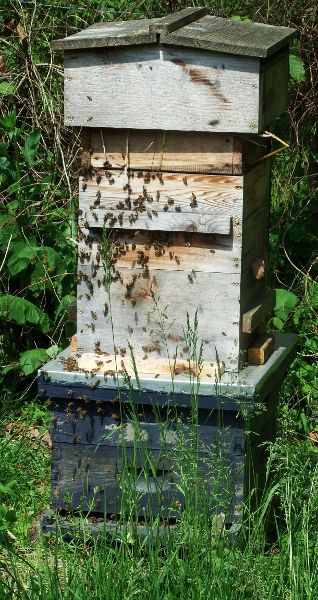
What I like about the Warre beekeeping method
 As I've mentioned, I like parts of both the Warre and Langstroth hive systems. So even though we're currently converting our colony from the former to the latter,
I'm not ready to throw in the towel on Warre methods. Here are some
Warre components I'm considering incorporating into our new system:
As I've mentioned, I like parts of both the Warre and Langstroth hive systems. So even though we're currently converting our colony from the former to the latter,
I'm not ready to throw in the towel on Warre methods. Here are some
Warre components I'm considering incorporating into our new system:
- The insulated "quilt" box. I can't see anything not to love about helping the hive retain heat in the winter by adding a layer of insulation on top. However, straw doesn't seem to be the best filler material since it breeds ants. I'm thinking of transferring over to a sheet of solid styrofoam insulation in the next iteration of the hive.
- Leaving the bees alone as much as possible. In all honesty, I suspect this is why bees survive so well in Warre hives, and I hope to maintain hands-off methods despite returning to Langstroth boxes.
- Nadiring instead of supering. I'm undecided on this one. On the one hand, nadiring makes it possible for me not to disrupt the hive while still knowing when the bees need more space, since the empty box is just above the screened bottom board and can be examined photographically. On the other hand, nadiring becomes physically difficult once a hive reaches a certain size, and one of the reasons to return to the Langstroth hive is to get more (heavy) honey. I suspect I might use the modified Warre method of nadiring the first box or two in the spring, then supering for later honey flows.
By the way, I should
mention that the primary reason we're converting our Warre hive back to
Langstroth is because both places we ordered bees from this year fell
through. One company changed their shipping method to the US Postal
Service (which I'm okay with) but refused to insure the bees traveling
that way (which I'm not okay with). The other company pushed back their
shipping date twice and then threw in the towel and said they wouldn't
be sending out bees at all this year. Two refunds behind me, I figured
I'd better focus on the hive I have on hand. Maybe next year we'll be
able to expand our apiary and will be able to put what I'm learning this
year to use!
Want more in-depth information? Browse through our books.
Or explore more posts by date or by subject.
About us: Anna Hess and Mark Hamilton spent over a decade living self-sufficiently in the mountains of Virginia before moving north to start over from scratch in the foothills of Ohio. They've experimented with permaculture, no-till gardening, trailersteading, home-based microbusinesses and much more, writing about their adventures in both blogs and books.
Want to be notified when new comments are posted on this page? Click on the RSS button after you add a comment to subscribe to the comment feed, or simply check the box beside "email replies to me" while writing your comment.

You have had bees around for years now, yet I've never read of you enjoying the first taste of honey. Have you had any harvest, or deferred the pleasure to "save the bees"?
Moisture quilts on a Langstroth are definitely possible. I made one last year out of a shallow super box with landscape fabric stapled to the bottom, and filled the box part way up with wood shavings. I would probably use some other kind of cloth than landscape fabric next time, since the stringy fibers ended up catching a few bees. Another beekeeper I talked to said he liked the idea of the moisture quilt, but would have filled the box all the way up with shavings. Couldn't hurt!
Caveat: my bees didn't make it through the winter, but I don't think it had anything to do with moisture buildup.